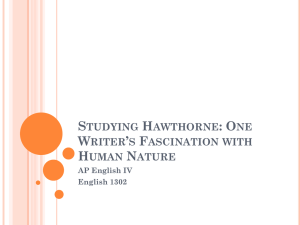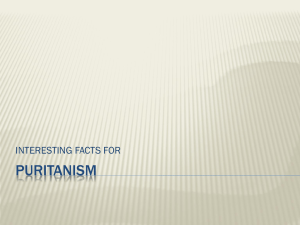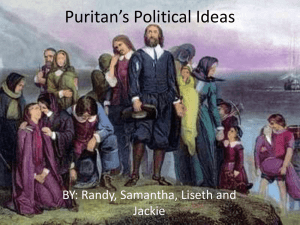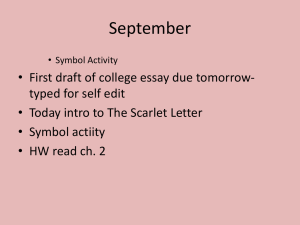Nathaniel Hawthorne and the Puritan Influence
advertisement
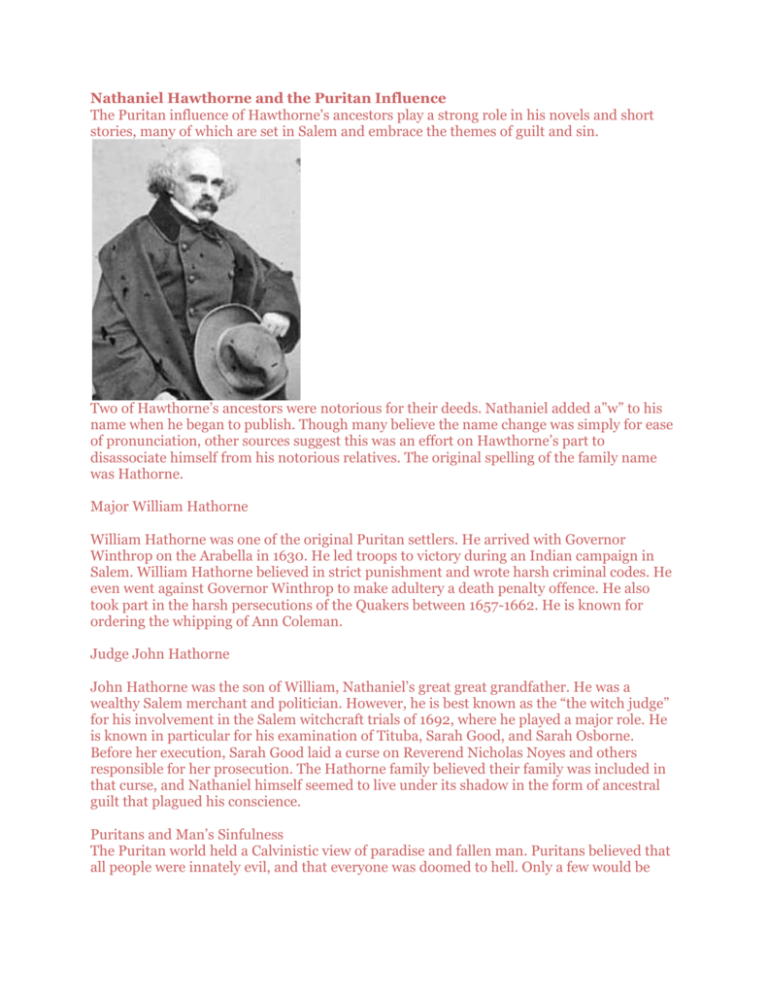
Nathaniel Hawthorne and the Puritan Influence The Puritan influence of Hawthorne's ancestors play a strong role in his novels and short stories, many of which are set in Salem and embrace the themes of guilt and sin. Two of Hawthorne’s ancestors were notorious for their deeds. Nathaniel added a”w” to his name when he began to publish. Though many believe the name change was simply for ease of pronunciation, other sources suggest this was an effort on Hawthorne’s part to disassociate himself from his notorious relatives. The original spelling of the family name was Hathorne. Major William Hathorne William Hathorne was one of the original Puritan settlers. He arrived with Governor Winthrop on the Arabella in 1630. He led troops to victory during an Indian campaign in Salem. William Hathorne believed in strict punishment and wrote harsh criminal codes. He even went against Governor Winthrop to make adultery a death penalty offence. He also took part in the harsh persecutions of the Quakers between 1657-1662. He is known for ordering the whipping of Ann Coleman. Judge John Hathorne John Hathorne was the son of William, Nathaniel’s great great grandfather. He was a wealthy Salem merchant and politician. However, he is best known as the “the witch judge” for his involvement in the Salem witchcraft trials of 1692, where he played a major role. He is known in particular for his examination of Tituba, Sarah Good, and Sarah Osborne. Before her execution, Sarah Good laid a curse on Reverend Nicholas Noyes and others responsible for her prosecution. The Hathorne family believed their family was included in that curse, and Nathaniel himself seemed to live under its shadow in the form of ancestral guilt that plagued his conscience. Puritans and Man’s Sinfulness The Puritan world held a Calvinistic view of paradise and fallen man. Puritans believed that all people were innately evil, and that everyone was doomed to hell. Only a few would be saved. Good deeds would not help an individual get into heaven, and the entire community would be condemned for one person’s bad behavior. Their beliefs made them intolerant of any kind of pleasure. There were many strict rules of conduct, and punishment for the smallest infraction. Common forms of punishment ranged from public whippings, confinement in the stocks or pillory, branding such as the branding of a B for burglar on the forehead, and hanging. Disobedience, speaking ill of court or judge or minister, playing cards or dice, denying any part of the Bible, telling lies, defying the Sabbath, being idle, wearing clothing of the opposite sex, and marrying a brother’s widow were all punishable crimes. Sexual crimes such as adultery and bigamy and fornication were judged harshly. Puritan Influence in Hawthorne’s Works Hawthorne made use of Salem and the Puritan setting for many of his works. Quite a few of Hawthorne’s stories are an analysis of the sins of his ancestors. His themes explore guilt, hypocrisy, and hidden sins. They are often told in allegorical form, which means they have a symbolic meaning as well as a literal one. Hawthorne’s characters often battle the good and evil within themselves, making his books examples of the earliest psychological novels in modern literature. Guilt and remorse are common themes in many of Hawthorne’s works, including his most well-known novels The Scarlet Letter and The House of the Seven Gables. Perceptions of good versus evil is also a recurring theme which is explored in the short story Young Goodman Brown. Caught between guilt feelings stemming from his Puritan roots and new ways of thinking, Hawthorne embraced contemporary thoughts and ideas. In 1842, he became friends with Ralph Waldo Emerson and the Transcendentalists in Concord, who believed in the existence of an ideal spiritual reality that transcended the material world. Hawthorne’s prose may be nineteenth century, but his themes are as timely today as they were when he wrote them. The conflict of church and state, the rightness or wrongness of capital punishment, among other issues, are problems that still plague society today. Sources: Kunitz, Stanley J. (editor). American Authors 1600-1900. Bronx, NY. H. W. Wilson, 1977. ISBN 0824200012 Johnson, Claudine Durst. Understanding the Scarlet Letter: A Student Casebook to Issues, Sources and Historical Documents. Westport, CT. Greenwood Press, 1995. How Puritans are Portrayed in the Scarlet Letter: And Why It's Important Today What if you had a secret that could kill you if you shared it? In Nathaniel Hawthorne's novel, The Scarlet Letter, such a secret tortures one of the main characters. His guilty conscience puts him through agony while he keeps the secret to himself; but his fear of shame and possible death prevents him from telling it to anyone. Why does his secret cause him so much pain? It is because he lives in a Puritan society, in seventeenth-century Boston where the punishment of sin is strict and severe. Hawthorne's portrayal of Puritans puts them in a bad light, making them look cruel, judgmental, narrow-minded, and altogether unlikable. Hawthorne first portrays Puritans in a bad light in the lengthy introductory, where he speaks of one of his Puritan ancestors. He describes him as having “all the Puritanic traits, both good and evil.” Because the author uses the word “evil” to describe them, we automatically think of them as bad guys in the story; although, since he does say they have “good” traits as well, we don't go as far as despising them – at least not yet. He continues to describe his ancestor as “a bitter persecutor” that is remember by the Quakers as having “hard severity towards a woman of their sect, which will last longer, it is to be feared, than any record of his better deeds, although these were many.” Clearly Hawthorne wanted to stress that the Puritans were not altogether evil; however, they were certainly the last people with whom anyone would want to hang around! In the next sentence, Hawthorne speaks of his ancestor's son, who “made himself so conspicuous in the martyrdom of the witches, that their blood may fairly be said to have left a stain upon him.” The author's use of the word martyrdom is interesting. It almost elevates the witches as heroes, and the Puritan judges who condemned them as the cruel, merciless enemies. In fact, this is not the last time in this book where Hawthorn portrays a sinner positively, and the person who condemns the sinner negatively. Later Hawthorne writes, “I know not whether these ancestors of mine bethought themselves to repent, and ask pardon of Heaven for their cruelties...” He then prays that “any curse incurred by them... may be now and henceforth removed.” If he took the time to actually pray against any curse that might have passed down from his Puritan ancestors, than we can conclude that Hawthorne truly believed they were not good people! We see more of the Puritans' cruelty represented in Chapter 2, where a group of women are disappointed that Hester, an adulterer, is not receiving a harsh enough punishment for her sin. Hester is forced to wear the letter “A” on the chest, and to stand on the town scaffold for hours as the whole town stares at her in judgment. However, these women say it is not enough. One insists that she should be branded on the forehead with a hot iron; another says she should be put to death! The story blatantly portrays Puritans as pitiless and coldhearted, but that's not the only bad quality it gives them. Later in the story, Puritans are revealed as being narrow-minded, and basically closed to all views and lifestyles other than their own. Also in Chapter 2, the author refers to Hester's letter “A” as being “a splendor in accordance with the taste of the age, but greatly beyond what was allowed by the sumptuary regulations of the colony.” From this quote, we learn that even the most fashionable styles in the world were frowned upon by Puritans. Chapter 21 mentions a sailor who wore an elaborate attire of ribbons on his clothing, and a hat with gold-lace, a gold chain, and a feather; then goes on to say that if any of the citizens of Boston were to dress like him, they would have undergone “stern question before a magistrate, and probably incurring fine or imprisonment, or perhaps an exhibition in the stocks.” Hawthorne wants to make it clear that the Puritans in Boston were an isolated society who thought all worldly ideas – even the latest fashions – were sinful. This gives us a hint at what their hearts may have been like; because if they judged people for simply dressing the wrong way, than how much more judgmental and narrow-minded might they have been toward people who committed more serious sins? In addition to making the Puritans look like people of bad character, Hawthorne portrays them as visually unlikable people. He describes them in the introductory as “stern and black-browed”, and in Chapter 2 uses words to describe them like “grim” and “iron-visage”. The only person that is associated with beauty is the adulterer, Hester. Hawthorne says of her: “The young woman was tall, with a figure of perfect elegance on a large scale. She had dark and abundant hair, so glossy that it threw off the sunshine with a gleam, and a face which, besides being beautiful from regularity of feature and richness of complexion, had the impressiveness belonging to a marked brow and deep black eyes.” We can judge by Hawthorne's diction in describing the Puritans and Hester that he wanted us to think lowly of the former, and highly of the latter. Hawthorne repeats again and again throughout The Scarlet Letter the cruelty, judgmental attitude, narrow-mindedness, and numerous unlikable features of the Puritans. He shows them as condemning sinners mercilessly, refusing to accept ideas that are foreign to their ways of living or thinking, and being physically – and inwardly – ugly. However, his portrayal of Puritans is probably inaccurate, or at least exaggerated. The real Puritans had many of the wholesome traits and values that went into the founding of this nation. Sometimes Hawthorne's representation of Puritans is used as a stereotype for all Christians today. Unbelievers often assume that Christians are self-righteous and unforgiving, but we know this stereotype goes against what the Bible teaches. Leviticus 19:18 says to “love your neighbor as yourself”, and Jesus commands us in John 15:12 to “love one another as I have loved you”. Also, Romans 12:17 says to “repay no one evil for evil”. In order to fit the Puritan/Christian stereotype, one would have to behave as if he were not a Christian! While Hawthorne's image of church-goers may work in fiction, it doesn't match reality.


